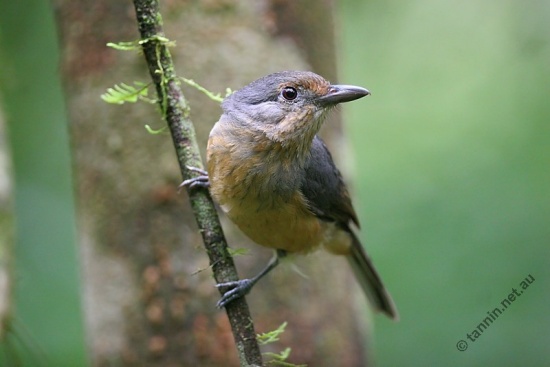Alternative names: Stripe-breasted Shrike-thrush; Stripe-breasted Thrush; Bower Thrush
- Colluricincla boweri
Identification
19.5 - 21cm.
- Blue grey head and back
- Variable rufous on wings related to age
- Pale grey lores and grey eye-ring
- Cinnamon breast
- Throat and breast finely grey streaked
- Black bill
Females and immatures have a pale grey bill, rufous lores and eyebrow and a pale eye-ring. Juveniles have a pale bill.
Similar species
Similar to Rufous Shrikethrush which is slightly smaller and has a pinkish-brown bill.
Distribution
Northeast Queensland in northeast Australia.
Has a small range but it's quite common in it.
Taxonomy
This is a monotypic species[1].
Habitat
Mid canopy of upland rainforests above 300m.
Behaviour
Resident species.
Diet
The diet includes insects and their larvae. Takes occasionally frogs.
Breeding
Breeding season from September to December. The nest is a compact cup made of rootlets, dead leaves, twigs, fronds and bark strips. It's placed around 3.5m above the ground in a tree fork or a sapling. Lays 2, sometimes 3 eggs.
References
- Clements, JF. 2008. The Clements Checklist of Birds of the World. 6th ed., with updates to December 2008. Ithaca: Cornell Univ. Press. ISBN 978-0801445019.
- Del Hoyo, J, A Elliott, and D Christie, eds. 2007. Handbook of the Birds of the World. Volume 12: Picathartes to Tits and Chickadees. Barcelona: Lynx Edicions. ISBN 978-8496553422
- Simpson, K and N Day. 1998. Field Guide to the Birds of Australia. London: Christopher Helm. ISBN 0-7136-4877-5
Recommended Citation
- BirdForum Opus contributors. (2025) Bower's Shrikethrush. In: BirdForum, the forum for wild birds and birding. Retrieved 13 May 2025 from https://www.birdforum.net/opus/Bower%27s_Shrikethrush




